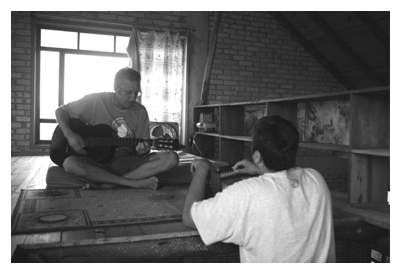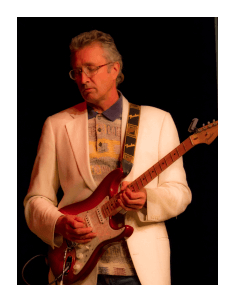PRESS RELEASE
Titiksava Karunika: A Mantra Rockin’ Good Time
By Madhava Smullen for ISKCON News on 3 Sep 2011
It wasn’t weighty philosophical concepts that first opened the door to Krishna consciousness for mantra rock musician Titiksava Karunika Dasa, known affectionately by fans and fellow devotees as T.K.
It was good, old-fashioned rock ‘n’ roll.
“It was 1970, and George Harrison’s All Things Must Pass album had just come out,” he recalls. “I went to see him in concert, and when he played the hit single from it, My Sweet Lord, he asked everyone in the audience to chant Hare Krishna.”
When T.K., then only eighteen years old and known as Thomas Plummer, emerged from the concert, he was approached by Hare Krishna devotees who offered him a free ticket to the next show—if he would help pass out their flyers. He did so, and when he had finished the devotees gave him a sweetball to eat along with his concert ticket.
“I had just chanted Hare Krishna, done some service by passing out the flyers, and eaten prasadam,” T.K. says. “The seed of devotion had been planted.”
It took nearly ten years to fully blossom. In the meantime, Thomas Plummer—who had taught himself guitar at eleven years old from Beatles and Rolling Stones chordbooks—travelled the country, busking and later playing with rock band Smokestack Lightning. Finally, in 1979, when an ISKCON temple sprang up just down the street from his house in Berkely, California, he began to visit for the food, stayed for the chanting and the philosophy, and received the name Titikshava Karunika Dasa.
For three years, T.K. travelled around the country in a van with other devotees, distributing ISKCON Founder Srila Prabhupada’s books. But he never stopped playing guitar.

“At the Berkely temple at that time, we were encouraged to use our talents for Krishna,” he says. “Many of us would listen to Change of Heart and other albums by Mangalananda, who had been encouraged by Srila Prabhupada to write Krishna conscious songs. Some of us would even sing and play guitar while we were out on the road.”
T.K. began writing devotional songs, which seemed to just well up from somewhere deep in his soul. Trading the paintings he sometimes sold for recording equipment, he built a small studio behind the Los Angeles ISKCON temple, and started the band Krishnautix with keyboard player Govinda-bhasya Dasa in 1984.
“Just as Aeronautics is the science of aircraft, so Krishnautix is the science of Krishna,” T.K. explains. “Lord Chaitanya says that if anyone chants Krishna’s name even once, all their sinful activities will be nullified. So we hoped that anyone who just said the name of the band, which included Krishna’s name, would be benefited.”
Inspired by Mangalananda’s work and Prabhupada’s support of it, Krishnautix wanted to make an album that would stand up to it, and in 1986, the band released Try to Understand. Three more albums—Simply Surrender, All Souled Out, and Hold On—followed within five years.
With a dearth of Krishna conscious Western music at the time, devotees lapped them up. Songs like the heartfelt ballads “Krishna Never Leaves Vrindavana” and “Have Mercy on the Animals,” and later the unstoppably infectious “Good Time” became ISKCON anthems. T.K. became well-known around the world, often to his own surprise.
“I remember talking to some gurukula teachers in Mayapur, India, who said, ‘We don’t let the kids listen to Western music, but we let them listen to yours,’” he recalls. “I was so flattered. And over the years, I’ve met many devotee kids who tell me they grew up with my music.”
T.K. would play at Rathayatra festivals in LA and San Francisco, at the LA Govinda’s restaurant, and even sometimes at clubs with his old high school bandmates.
“I would show up in a dhoti with a shaved head and sing Good Time, chanting Hare Krishna right there in the club,” he says. “People would look around and say, ‘Is this guy serious?’ It was so bizarre and out of place, they didn’t know how to take it. But one time, as I was playing, the bartender came out onto the floor and started dancing and singing along. After the show, he went up to my bandmate and said, ‘Wow, I never thought I would chant and dance along with a Hare Krishna song in my life! That was so much fun!’”

In 1992, however, T.K. was about to experience a whole other level of audience enthusiasm.
“A devotee named Rama-Sraddha had just returned from a tour in Poland with the Gauranga Bhajan Band, which featured ISKCON musicians like Krishna Prema and Harikesa, as well as singing by ISKCON gurus Sacinandana Swami, Bhakti Vaibhava Swami, and Krishna Ksetra Dasa,” T.K. says. “He told me they were doing huge things, and I should hook up with them. He showed me videos of their last tour, and I was blown away.”
Getting the go-ahead from the organizers, and working his way up from mixer to having his own part in the show, T.K. joined the Gauranga Bhajan Band on their Russian tour.
“It was like nothing I’ve ever experienced before, and likely will never experience again,” he says. “The Iron Curtain had just dropped after decades of Communist oppression. Religious people in Russia had been violently suppressed and thrown in jail, and the only way anyone could hear a Beatles or a Rolling Stones record was if they got it on the black market. In fact, the two things that the Communist regime feared the most were religion and Western music. And now, suddenly, just as the Iron Curtain fell and people could do whatever they wanted, here was the Gauranga Bhajan Band, with a foreign religion and Western music rolled into one package! People went crazy for us.”
Everywhere they went, the Gauranga Bhajan Band—with its three-and-a-half hour show featuring drama, Bharat-Natyam Dance, traditional kirtan, and rock music—played at huge stadiums, drawing crowds of ten to twelve thousand people for every performance.
And with the Soviet government turned upside down, the State run by the people, and Western money akin to gold, the devotees were treated like megastars.
“We flew from city to city in a private jet that had been used by the President, for less than it cost to take the train in America,” says T.K. “And we rented huge state-of-the-art sound systems for only $2,000 that would have cost us $50,000 back home.”
Even all this, however, couldn’t have prepared the band for their final show, in Moscow. Staged at Luzhniki Stadium, the biggest stadium in Russia and home of the 1980 Summer Olympics, the show also featured pop star Boy George as a support act and drew an unbelievable 30,000 people.
“As soon as we walked into that place, we just went, ‘Oh my God,’” T.K. recalls. “We thought there was no way we could pull it off. It was just too big. We were all so scared. I remember as we stood backstage waiting to go on, B.B. Govinda Swami turned to me and said, “Don’t be scared. It’s okay. Everything’s going to be all right.” But I could tell he was terrified, too!”

“I was trembling when I walked out onto the stage,” T.K. continues. “But as soon as I started playing, all the fear just left. I knew it was no longer really me playing, but Krishna somehow orchestrating the whole thing. It was an amazing experience. Everyone came down from their seats and stood on the floor in front of the stage for three-and-a-half hours—30,000 people chanting Hare Krishna along with us and breaking into thunderous applause at every little thing we did.”
Although the Gauranga Bhajan Band never reached those giddy heights again, they continued to go from strength to strength, doing more successful tours and releasing the stunning album Chant. Eventually, however, they broke up, due to main organizer Harikesa’s health issues.
But T.K. didn’t have to wait long for his next gig.
“In 1994, I got a call from devotees in Slovenia, who wanted me to play with their rock band, Transcendence,” he says.
The shows that Transcendence put on in town squares around Slovenia for two or three hundred people were a far cry from the gigantic stadiums of Russia—but they were no less fun, and deeply impactful in their own right.
“We would play two or three squares every week throughout the summer,” says T.K. “We had a nineteen-man crew that would set up our own stage, lights, and sound system, and we would put on a whole show, starting with traditional bhajans, and transforming into rock. People would show up, dance and chant along with us, and afterwards we would sell tapes, books, and prasadam. It was a very nice mood, and the first year we toured seventeen new devotees joined the temple. I remember those times very fondly.”
After three albums with Transcendence, T.K. married Saci Mata Dasi, and slowed down his touring and recording for some time as he started a family. Still, he managed to put out two more albums under the new name Namrock—1998’s Top Secret and 2007’s It’s My Nature—which rocks just as hard as ever and retains the same poignant, thought-provoking messages.
“I have softened up since my brahmachari days, when I was out trying to make everyone a Hare Krishna,” he says. “The name Namrock is a little more accessible, and some of my songs, although they have deep devotional meaning to me, can be taken in a more universal way.”

Today, T.K. continues to play at temples and Hare Krishna Festivals around the USA, performing to tens of thousands at ISKCON Utah’s Festival of Colors this year. He’s also planning to release an album with San Diego rock/blues band Radiance, who are not ISKCON devotees but whose songs are introspective and spiritual in the typical T.K. style.
T.K. has even branched out into other devotional arts this year, releasing a family adventure movie called The Magic Crystal. The movie, which T.K. made because he wanted to see an original Krishna conscious film for children, stars his own son and daughter as a self-centered, materialistic boy and his devoted younger sister. The two find a jewel that bestows immense wealth upon anyone who possesses it. They then embark on a quest to deliver the jewel to its rightful place, during which they encounter a mystic yogi, have an out-of-body-experience, and are chased by Kung Fu villains. Along the way, they learn what is truly important in life.
“It was mantra rock that brought me to Krishna consciousness, at George Harrison’s concert,” he says. “I was as far away from God- and self-realization as I could get, and I know that without that bridge of music, I never would have become a devotee. So I just want to give that gift to others. The rock music is like the candy coating around the medicine of the Hare Krishna maha-mantra. It might take a long time to convince someone about Krishna consciousness if you try to explain it to them intellectually. But if they walk into a concert where everybody’s chanting and dancing and having a good time, they’ll get it right away.”
A broad, infectious grin spreads across his face. “And that’s all I want, really—to see people chanting Hare Krishna and having a good time.”
You don’t have to drive a fancy car to have a good time
You don’t have to be a Hollywood star to have a good time
You don’t have to own a house or yacht
You can be satisfied with what you’ve already got
…And have a good time
There’s just one thing that I want you to try
Just this one time, before you gotta lay down and die:
Hare Krishna Hare Krishna, Krishna Krishna Hare Hare
Hare Rama Hare Rama, Rama Rama Hare Hare

